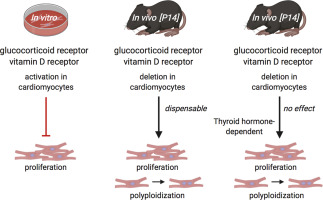当前位置:
X-MOL 学术
›
J. Mol. Cell. Cardiol.
›
论文详情
Our official English website, www.x-mol.net, welcomes your
feedback! (Note: you will need to create a separate account there.)
In vitro and in vivo roles of glucocorticoid and vitamin D receptors in the control of neonatal cardiomyocyte proliferative potential.
Journal of Molecular and Cellular Cardiology ( IF 4.9 ) Pub Date : 2020-04-11 , DOI: 10.1016/j.yjmcc.2020.04.013 Stephen Cutie 1 , Alexander Y Payumo 1 , Dominic Lunn 1 , Guo N Huang 1
Journal of Molecular and Cellular Cardiology ( IF 4.9 ) Pub Date : 2020-04-11 , DOI: 10.1016/j.yjmcc.2020.04.013 Stephen Cutie 1 , Alexander Y Payumo 1 , Dominic Lunn 1 , Guo N Huang 1
Affiliation

|
Cardiomyocyte (CM) proliferative potential varies considerably across species. While lower vertebrates and neonatal mammals retain robust capacities for CM proliferation, adult mammalian CMs lose proliferative potential due to cell-cycle withdrawal and polyploidization, failing to mount a proliferative response to regenerate lost CMs after cardiac injury. The decline of murine CM proliferative potential occurs in the neonatal period when the endocrine system undergoes drastic changes for adaptation to extrauterine life. We recently demonstrated that thyroid hormone (TH) signaling functions as a primary factor driving CM proliferative potential loss in vertebrates. Whether other hormonal pathways govern this process remains largely unexplored. Here we showed that agonists of glucocorticoid receptor (GR) and vitamin D receptor (VDR) suppressed neonatal CM proliferation. We next examined CM nucleation and proliferation in neonatal mutant mice lacking GR or VDR specifically in CMs, but we observed no difference between mutant and control littermates at postnatal day 14. Additionally, we generated compound mutant mice that lack GR or VDR and express dominant-negative TH receptor alpha in their CMs, and similarly observed no increase in CM proliferative potential compared to dominant-negative TH receptor alpha mice alone. Thus, although GR and VDR activation is sufficient to inhibit CM proliferation, they seem to be dispensable for neonatal CM cell-cycle exit and polyploidization in vivo. In addition, given the recent report that VDR activation in zebrafish promotes CM proliferation and tissue regeneration, our results suggest distinct roles of VDR in zebrafish and rodent CM cell-cycle regulation.
中文翻译:

糖皮质激素和维生素D受体在控制新生儿心肌细胞增殖潜力中的体外和体内作用。
物种间心肌细胞(CM)的增殖潜力差异很大。虽然低等脊椎动物和新生哺乳动物保留了强大的CM增殖能力,但成年哺乳动物CM由于细胞周期停药和多倍体化而丧失了增生潜能,在心脏损伤后未能引起增殖反应以再生失去的CM。当新生儿的内分泌系统发生剧烈变化以适应子宫外生活时,鼠CM增殖潜能就会下降。我们最近证明,甲状腺激素(TH)信号传导是驱动脊椎动物CM增殖潜能丧失的主要因素。是否还有其他激素途径支配这一过程在很大程度上尚待探索。在这里,我们显示了糖皮质激素受体(GR)和维生素D受体(VDR)的激动剂抑制了新生儿CM的增殖。接下来,我们检查了在CM中缺少GR或VDR的新生突变小鼠中CM的成核和增殖,但是在出生后第14天,我们观察到突变和对照同窝仔之间没有差异。此外,我们生成了缺少GR或VDR并表达显性的复合突变小鼠。它们的CM中的TH受体α阴性,并且与单独的显性阴性TH受体α小鼠相比,CM增殖潜能也没有增加。因此,尽管GR和VDR激活足以抑制CM增殖,但它们似乎对于新生儿CM细胞周期退出和体内多倍化是必不可少的。此外,
更新日期:2020-04-12
中文翻译:

糖皮质激素和维生素D受体在控制新生儿心肌细胞增殖潜力中的体外和体内作用。
物种间心肌细胞(CM)的增殖潜力差异很大。虽然低等脊椎动物和新生哺乳动物保留了强大的CM增殖能力,但成年哺乳动物CM由于细胞周期停药和多倍体化而丧失了增生潜能,在心脏损伤后未能引起增殖反应以再生失去的CM。当新生儿的内分泌系统发生剧烈变化以适应子宫外生活时,鼠CM增殖潜能就会下降。我们最近证明,甲状腺激素(TH)信号传导是驱动脊椎动物CM增殖潜能丧失的主要因素。是否还有其他激素途径支配这一过程在很大程度上尚待探索。在这里,我们显示了糖皮质激素受体(GR)和维生素D受体(VDR)的激动剂抑制了新生儿CM的增殖。接下来,我们检查了在CM中缺少GR或VDR的新生突变小鼠中CM的成核和增殖,但是在出生后第14天,我们观察到突变和对照同窝仔之间没有差异。此外,我们生成了缺少GR或VDR并表达显性的复合突变小鼠。它们的CM中的TH受体α阴性,并且与单独的显性阴性TH受体α小鼠相比,CM增殖潜能也没有增加。因此,尽管GR和VDR激活足以抑制CM增殖,但它们似乎对于新生儿CM细胞周期退出和体内多倍化是必不可少的。此外,











































 京公网安备 11010802027423号
京公网安备 11010802027423号